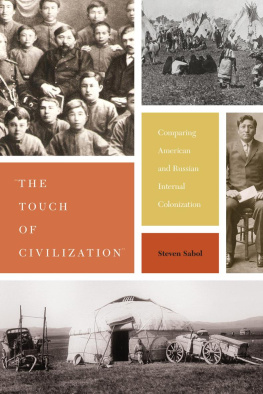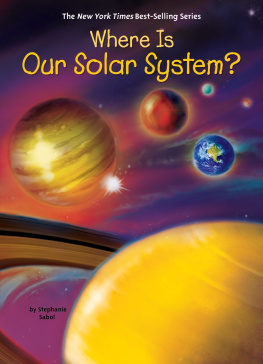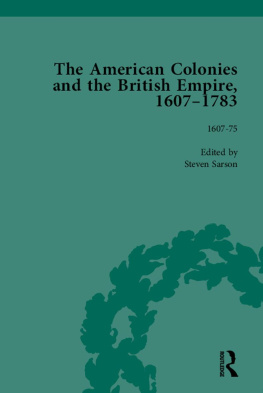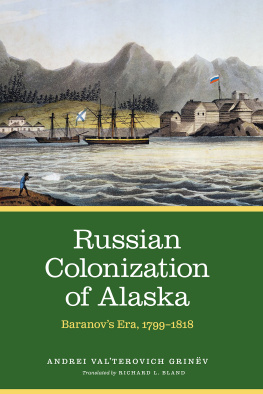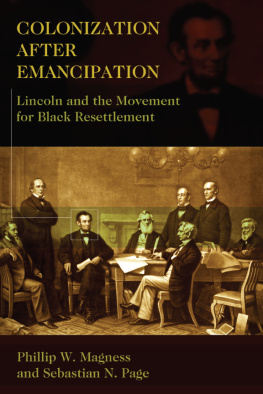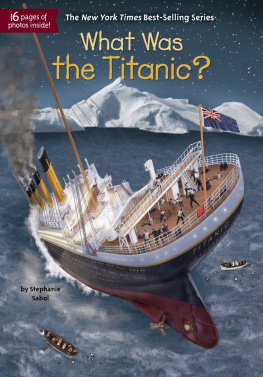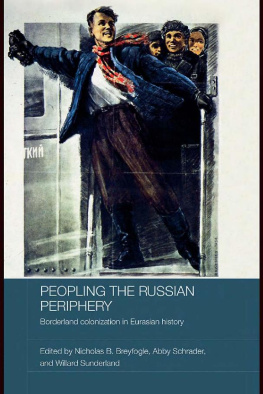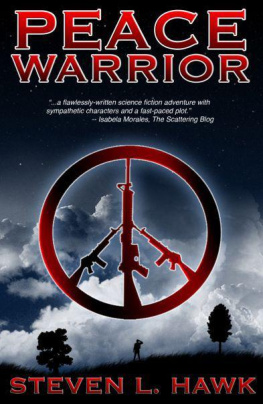Steven Sabol - The Touch of Civilization: Comparing American and Russian Internal Colonization
Here you can read online Steven Sabol - The Touch of Civilization: Comparing American and Russian Internal Colonization full text of the book (entire story) in english for free. Download pdf and epub, get meaning, cover and reviews about this ebook. year: 2017, publisher: University Press of Colorado, genre: Politics. Description of the work, (preface) as well as reviews are available. Best literature library LitArk.com created for fans of good reading and offers a wide selection of genres:
Romance novel
Science fiction
Adventure
Detective
Science
History
Home and family
Prose
Art
Politics
Computer
Non-fiction
Religion
Business
Children
Humor
Choose a favorite category and find really read worthwhile books. Enjoy immersion in the world of imagination, feel the emotions of the characters or learn something new for yourself, make an fascinating discovery.
- Book:The Touch of Civilization: Comparing American and Russian Internal Colonization
- Author:
- Publisher:University Press of Colorado
- Genre:
- Year:2017
- Rating:5 / 5
- Favourites:Add to favourites
- Your mark:
- 100
- 1
- 2
- 3
- 4
- 5
The Touch of Civilization: Comparing American and Russian Internal Colonization: summary, description and annotation
We offer to read an annotation, description, summary or preface (depends on what the author of the book "The Touch of Civilization: Comparing American and Russian Internal Colonization" wrote himself). If you haven't found the necessary information about the book — write in the comments, we will try to find it.
Steven Sabol: author's other books
Who wrote The Touch of Civilization: Comparing American and Russian Internal Colonization? Find out the surname, the name of the author of the book and a list of all author's works by series.
The Touch of Civilization: Comparing American and Russian Internal Colonization — read online for free the complete book (whole text) full work
Below is the text of the book, divided by pages. System saving the place of the last page read, allows you to conveniently read the book "The Touch of Civilization: Comparing American and Russian Internal Colonization" online for free, without having to search again every time where you left off. Put a bookmark, and you can go to the page where you finished reading at any time.
Font size:
Interval:
Bookmark:
George ONeal Sutton (18961982).
but history was his passion.
5589 Arapahoe Avenue, Suite 206C
Boulder, Colorado 80303
Printed in the United States of America
 The University Press of Colorado is a proud member of The Association of American University Presses.
The University Press of Colorado is a proud member of The Association of American University Presses.ISBN: 978-1-60732-550-5 (ebook)
Title: The touch of civilization : comparing American and Russian internal colonization / Steve Sabol.
Description: Boulder, Colorado : University Press of Colorado, [2017] | Includes bibliographical references and index.
Identifiers: LCCN 2016036164 | ISBN 9781607325499 (cloth) | ISBN 9781607325505 (ebook)
Subjects: LCSH: Comparative civilization. | ImperialismHistory. | United StatesTerritorial expansion. | RussiaTerritorial expansion. | Collective memoryRussia. | Collective memoryUnited States. | Dakota IndiansHistory. | KazakhsHistory.
Classification: LCC CB451 .S23 2016 | DDC 909dc23
LC record available at https://lccn.loc.gov/2016036164
 An electronic version of this book is freely available, thanks to the support of libraries working with Knowledge Unlatched. KU is a collaborative initiative designed to make high-quality books open access for the public good. The open access ISBN for the PDF version of this book is 978-1-60732-698-4; for the ePUB version the open access ISBN is 978-1-60732-725-7. More information about the initiative and links to the open-access version can be found at www.knowledgeunlatched.org.
An electronic version of this book is freely available, thanks to the support of libraries working with Knowledge Unlatched. KU is a collaborative initiative designed to make high-quality books open access for the public good. The open access ISBN for the PDF version of this book is 978-1-60732-698-4; for the ePUB version the open access ISBN is 978-1-60732-725-7. More information about the initiative and links to the open-access version can be found at www.knowledgeunlatched.org.The Sioux And The Kazakhs
Pre-Nineteenth-Century Expansion
Conquest and Martial Resistance
Through the Colonial Looking-Glass
Internal Colonization
Assimilation and Identity
Font size:
Interval:
Bookmark:
Similar books «The Touch of Civilization: Comparing American and Russian Internal Colonization»
Look at similar books to The Touch of Civilization: Comparing American and Russian Internal Colonization. We have selected literature similar in name and meaning in the hope of providing readers with more options to find new, interesting, not yet read works.
Discussion, reviews of the book The Touch of Civilization: Comparing American and Russian Internal Colonization and just readers' own opinions. Leave your comments, write what you think about the work, its meaning or the main characters. Specify what exactly you liked and what you didn't like, and why you think so.

